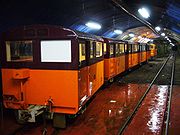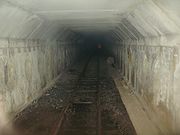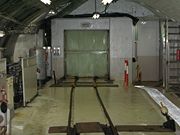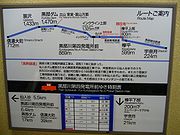
Kurobe Senyo Railway
Encyclopedia

Japan
Japan is an island nation in East Asia. Located in the Pacific Ocean, it lies to the east of the Sea of Japan, China, North Korea, South Korea and Russia, stretching from the Sea of Okhotsk in the north to the East China Sea and Taiwan in the south...
ese industrial railway
Industrial railway
An industrial railway is a type of railway that is not available for public transportation and is used exclusively to serve a particular industrial, logistics or military site...
line in Toyama Prefecture
Toyama Prefecture
is a prefecture of Japan located in the Hokuriku region on Honshū island. The capital is the city of Toyama.Toyama is the leading industrial prefecture on the Japan Sea coast, and has the industrial advantage of cheap electricity due to abundant water resources....
, operated by Kansai Electric Power Company
Kansai Electric Power Company
, also known as , is an electric utility with its operational area of Kansai region, Japan . The company is regarded as one of the leading companies in Kansai, as well as a leader of the Japanese electric power industry....
. There are two lines, namely and . The two lines go to hydroelectric
Hydroelectricity
Hydroelectricity is the term referring to electricity generated by hydropower; the production of electrical power through the use of the gravitational force of falling or flowing water. It is the most widely used form of renewable energy...
power plants of Kurobe River
Kurobe River
The is a river in Toyama Prefecture, Japan. 86 km in length, it has a watershed of 689 km².The river rises from Mount Washiba in the Hida Mountains and carves the deep valley known as the Kurobe gorge...
. These lines are basically not open to public. This article is mainly about Jōbu Track.
Overview

Kurobe dam
The or , is a variable-radius arch dam on the Kurobe River in Toyama Prefecture on the island of Honshū, Japan. It supports the 335 MW Kurobe No. 4 Hydropower Plant and is owned by Kansai Electric Power Company. At high, it is the tallest dam in Japan. It was constructed between 1956 and 1963 at...
. From Keyakidaira, Kurobe Gorge Railway
Kurobe Gorge Railway
The , or for short, is a private 762 mm narrow gauge railway company operating the Kurobe Gorge Main Line along the Kurobe River in the Kurobe gorge area of Toyama Prefecture, Japan...
Main Line runs to Unazuki
Unazuki Station
is a train station in Kurobe, Toyama Prefecture, Japan.-Structure:One island platform with two tracks and side tracks on ground. Platforms are located lower than the station building...
neighbouring Unazukionsen
Unazukionsen Station
is a train station in Kurobe, Toyama Prefecture, Japan.-Adjacent stations:...
of Toyama Chihō Railway
Toyama Chiho Railway
thumb|Type 9000 tramcar "Centram"The is a transportation company in Toyama, Toyama, Japan. The company is commonly known as . The private company operates railway, tram, and bus lines in the eastern part of the prefecture. It also operates as the agency of All Nippon Airways in Toyama area. The...
Main Line
Toyama Chiho Railway Main Line
The is a Japanese railway line that connects Dentetsu-Toyama Station in Toyama, Toyama Prefecture with Unazukionsen Station in Kurobe, Toyama Prefecture. It is owned and run by Toyama Chihō Railway.-Station list:...
. As a counterpart the tunnels are divided into 42 parts by the of Jōbu Track (literally meaning "Upper Track"), Kurobe Gorge Railway Main Line is sometimes called .
The section between Keyakidaira and Sennindani was built in 1941 for the construction of Kurobegawa No.3 Power Station. The section between Sennindani and Kurobegawa No.4 Power Station-mae was built in 1963, for the construction of the said power station.
The construction of the section called was difficult. The temperature of rocks there was 160 °C (320 °F) at the time. It is now cooled off to 40 °C (104 °F).
Basic data
This is the data of Jōbu Track.- Distance: 6.4km
- GaugeRail gaugeTrack gauge or rail gauge is the distance between the inner sides of the heads of the two load bearing rails that make up a single railway line. Sixty percent of the world's railways use a standard gauge of . Wider gauges are called broad gauge; smaller gauges, narrow gauge. Break-of-gauge refers...
: 762 mm - Stations: 6
- Track: Single
- Power: Battery
Stations
Those in italics are not treated as "stations", but are merely depots. All stations are located in KurobeKurobe, Toyama
is a city located in Toyama, Japan.As of 2008, the city has an estimated population of 42,612 and the density of 99.9 persons per km². The total area is 426.34 km². The city was founded on April 1, 1954...
, Toyama
Toyama Prefecture
is a prefecture of Japan located in the Hokuriku region on Honshū island. The capital is the city of Toyama.Toyama is the leading industrial prefecture on the Japan Sea coast, and has the industrial advantage of cheap electricity due to abundant water resources....
, except of Kurobegawa No.4 Power Station-mae, which is located in Tateyama, Toyama
Tateyama, Toyama
is a town located in Nakaniikawa District, Toyama, Japan.As of 2003, the town has an estimated population of 28,123 and a density of 91.51 persons per km². The total area is 307.31 km².-External links:*...
.
- Altitude 800 m. Linked to Keyakidaira-Kabu (altitude 599m) by an elevator. Keyakidaira-Kabu is virtually the same station as Keyakidaira, Kurobe Gorge Railway Main Line.: Altitude 869 m (2,851 ft). Linked to Incline-Jōbu (altitude 1325m) by a funicular.
Services


The actual operation is done by Kurobe Gorge Railway Company, the wholly subsidiary of Kansai Electric Power Company.
A Kurobe Route carriage from Keyakidaira Station, Kurobe Gorge Railway Main Line, runs a short industrial railway line to Keyakidaira-Kabu Station, just 500 m (1,640 ft) away from Keyakidaira. From there, a large elevator
Elevator
An elevator is a type of vertical transport equipment that efficiently moves people or goods between floors of a building, vessel or other structures...
takes a carriage to Keyakidaira-Jōbu Station, 200 m (656 ft) above. The elevator was made in 1939 by Otis Elevator Company
Otis Elevator Company
The Otis Elevator Company is the world's largest manufacturer of vertical transportation systems today, principally focusing on elevators and escalators...
. It is the elevator with the largest maximum loading capacity in Japan, 4.5 t (4.4 LT). Kurobe Senyō Railway (Jōbu Track) begins from Keyakidaira-Jōbu Station, to Kurobegawa No.4 Power Station-mae Station. From there, a funicular goes to Incline Jōbu Station, 456 m (1,496 ft) above. Kurobe Tunnel (for a bus) links Incline Jōbu Station and Kurobe Dam
Kurobe dam
The or , is a variable-radius arch dam on the Kurobe River in Toyama Prefecture on the island of Honshū, Japan. It supports the 335 MW Kurobe No. 4 Hydropower Plant and is owned by Kansai Electric Power Company. At high, it is the tallest dam in Japan. It was constructed between 1956 and 1963 at...
Station of Kanden Tunnel Trolleybus
Kanden Tunnel Trolleybus
The is a Japanese trolleybus line between Ōgisawa Station, Ōmachi and Kurobe Dam Station, Tateyama. The line does not have any official name. The 6.1-km line runs almost entirely in a tunnel, except for about 300 metres at Ogisawa station and the approach to it. Opened in 1964, it is one of only...
, 10.3 km (6.4 mi) away.
Kurobe Route, including Jōbu Track, is basically not open to public. However, from 1996, participants of a study tour are allowed to take the route. Visitors have to book in advance. In most cases, there are more applicants than the limit, so they have to win a lottery to join the tour. In 2007, they had 34 tours with 2040 participants in total. For each tour, applicants were 2 to 8 times more than the limit.
Kuronagi Branch Line
Kuronagi Branch Line runs between of Kurobe Gorge Railway Main Line and , roughly 1.3 km (0.807784557644749 mi) away. The line has very infrequent services. As such, tourists going to the nearby can walk on the line track (tunnel) with permission by a Kuronagi Station attendant. Unlike Jōbu Track, the line is not entirely under a tunnel.See also
- Tateyama Sabō Erosion Control Works Service TrainTateyama Sabo Erosion Control Works Service TrainThe , commonly called , is a Japanese industrial railway line in Tateyama, Toyama. It is operated by the Tateyama Mountain Area Sabō Office, which belongs to the Hokuriku Regional Development Bureau of the Ministry of Land, Infrastructure and Transport.-Overview:...
- Kurobe Gorge RailwayKurobe Gorge RailwayThe , or for short, is a private 762 mm narrow gauge railway company operating the Kurobe Gorge Main Line along the Kurobe River in the Kurobe gorge area of Toyama Prefecture, Japan...
- Kanden Tunnel TrolleybusKanden Tunnel TrolleybusThe is a Japanese trolleybus line between Ōgisawa Station, Ōmachi and Kurobe Dam Station, Tateyama. The line does not have any official name. The 6.1-km line runs almost entirely in a tunnel, except for about 300 metres at Ogisawa station and the approach to it. Opened in 1964, it is one of only...
- Kurobe damKurobe damThe or , is a variable-radius arch dam on the Kurobe River in Toyama Prefecture on the island of Honshū, Japan. It supports the 335 MW Kurobe No. 4 Hydropower Plant and is owned by Kansai Electric Power Company. At high, it is the tallest dam in Japan. It was constructed between 1956 and 1963 at...
- Tateyama Kurobe Alpine RouteTateyama Kurobe Alpine RouteThe is a famous mountain sightseeing route between Tateyama, Toyama and Ōmachi, Nagano, Japan. The whole route opened on June 1, 1971.-Overview:The route is just 37 km in length, but the vertical interval is as large as 1,975m...
- Industrial railwayIndustrial railwayAn industrial railway is a type of railway that is not available for public transportation and is used exclusively to serve a particular industrial, logistics or military site...

